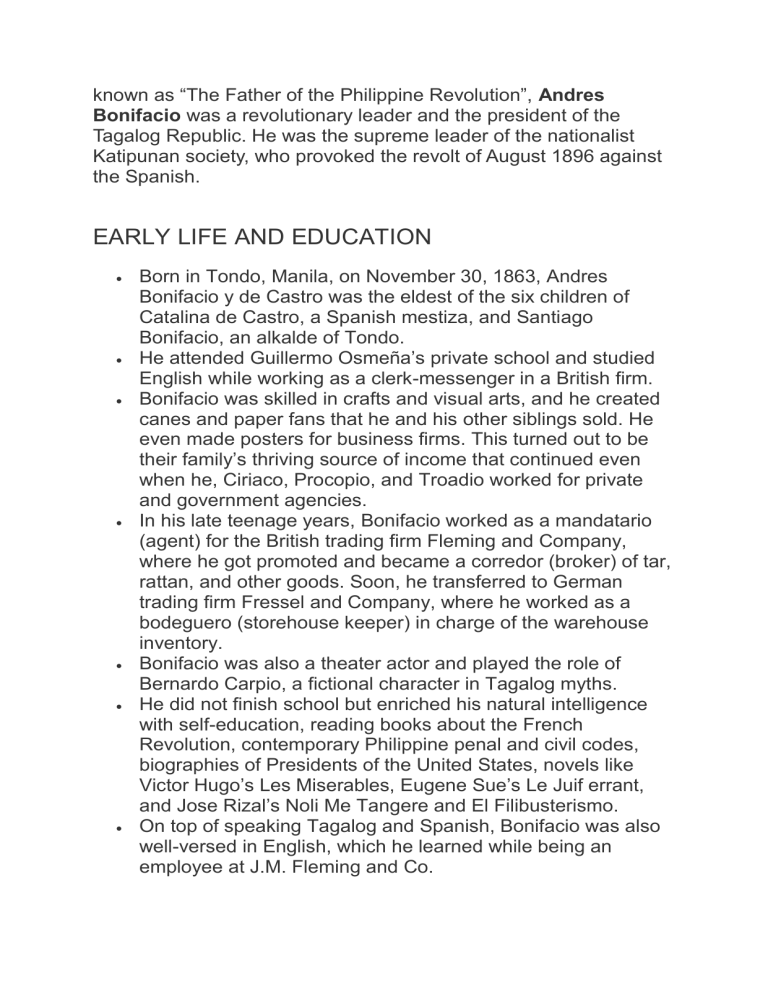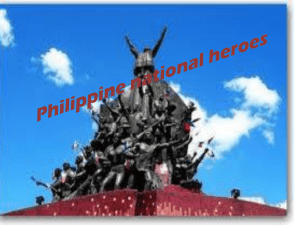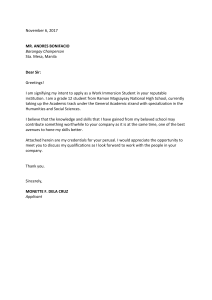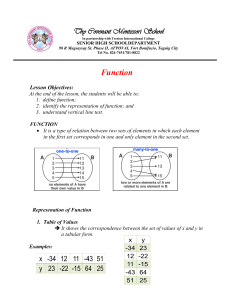
known as “The Father of the Philippine Revolution”, Andres Bonifacio was a revolutionary leader and the president of the Tagalog Republic. He was the supreme leader of the nationalist Katipunan society, who provoked the revolt of August 1896 against the Spanish. EARLY LIFE AND EDUCATION Born in Tondo, Manila, on November 30, 1863, Andres Bonifacio y de Castro was the eldest of the six children of Catalina de Castro, a Spanish mestiza, and Santiago Bonifacio, an alkalde of Tondo. He attended Guillermo Osmeña’s private school and studied English while working as a clerk-messenger in a British firm. Bonifacio was skilled in crafts and visual arts, and he created canes and paper fans that he and his other siblings sold. He even made posters for business firms. This turned out to be their family’s thriving source of income that continued even when he, Ciriaco, Procopio, and Troadio worked for private and government agencies. In his late teenage years, Bonifacio worked as a mandatario (agent) for the British trading firm Fleming and Company, where he got promoted and became a corredor (broker) of tar, rattan, and other goods. Soon, he transferred to German trading firm Fressel and Company, where he worked as a bodeguero (storehouse keeper) in charge of the warehouse inventory. Bonifacio was also a theater actor and played the role of Bernardo Carpio, a fictional character in Tagalog myths. He did not finish school but enriched his natural intelligence with self-education, reading books about the French Revolution, contemporary Philippine penal and civil codes, biographies of Presidents of the United States, novels like Victor Hugo’s Les Miserables, Eugene Sue’s Le Juif errant, and Jose Rizal’s Noli Me Tangere and El Filibusterismo. On top of speaking Tagalog and Spanish, Bonifacio was also well-versed in English, which he learned while being an employee at J.M. Fleming and Co. Childhood & Early Years Andrés Bonifacio y de Castro was born on November 30, 1863 in Tondo, Manila. Growing up in the slums of Tondo, he witnessed poverty and class struggle from a very close quarter. However contrary to popular belief, his family was not very poor. His father Santiago Bonifacio was a local politician who for a time served as the chief lieutenant of the municipal mayor. Later, he looked after his family by working in various capacities, such as tailoring and operating ferry services across the Pasig River. His mother Catalina de Castro was a Chinese mestiza. She worked as a supervisor in a cigarette factory. Born eldest of his parents’ six children, Andrés had five siblings named; Procopio de Castro Bonifacio, Espiradiona Bonifacio-Distrito, Trocadio De Castro Bonifacio, Maxima De Castro Bonifacio and Ciriaco de Castro De Castro. Little is known about his childhood, except that he learned the alphabets from his mother’s sister and eventually began his education at a private school, possibly run by certain Guillermo Osmeña from Cebu. He studied here for seven years only. When Andrés was still very young, his father contracted tuberculosis, which forced him to stop working. He died when Andrés was barely 13. A year later, his mother also passed away from the same disease. After that, it fell upon 14 years old Andrés to look after his younger siblings. In around 1877-1878, Andrés dropped out of school in order to earn his living. However, he continued his studies in private, reading books on subjects like French Revolution and biographies of the US Presidents etc. published in Spanish and Tagalog language. When he was in his late teens, he also picked up English and read internationally famous works like ‘Les Misérables’ by Victor Hugo, ‘Le Juif errant’ by Eugène Sue and ‘Noli Me Tángere’ and ‘El Filibusterismo’ by José Rizal etc. He also grew an interest in contemporary Philippine penal and civil codes. Andres Bonifacio’s heroism and struggle remain relevant to this day, with the lingering crisis affecting the overwhelming majority of Filipinos. After 125 years since he, along with his brothers, was killed for what he fought for, Filipinos now still suffer from poverty and oppression and the country is still under the influence and control of a foreign power. Contrary to what Bonifacio envisioned for poor and oppressed Filipinos during his time, Filipinos today continue to experience joblessness, rapidly rising prices of commodities and services, and insufficient social services and protection. Our economic policies are shaped by the dictates of foreign economic powers. Socio-political rights including the right to speak and access correct information are being curtailed or violated. Amid the pandemic, inequality even worsened, with oligarchs raking in bigger profits, while ordinary Filipinos continue to wallow in poverty. The working class from which Bonifacio hailed is among the basic classes bearing the brunt of the crisis. Bonifacio and the Katipunan’s struggle were fueled by their articulation of the true conditions of the people and the country and the call of their times to fight. But today, truth is being withheld from the people by the powers that be. Fake news and disinformation are proliferated to revise history, erase the atrocities of Martial Law from the people’s collective memory, and conceal the actual situation of Philippine economy and society. We celebrate Bonifacio’s life by emulating what he has done for the country. As teachers, it is our task to teach what heroes like Bonifacio have contributed for the country. The country during Bonifacio’s time was under centuries of direct colonization of Spain, its resources plundered and the people oppressed. Today, the country remains under heavy economic and political influence and control by the United States and other foreign powers. Our resources are plundered both by local and foreign corporations, and the people’s rights are violated and their welfare neglected. As educators, it is our task to help fight for our future by teaching students the need to contribute to the betterment of our society by way of their chosen profession, jobs and advocacies. Helping our students develop critical thinking means firmly asserting basic facts and truths against deliberate disinformation and social biases. Enabling our students to build nationalist attitudes means courageously seeking out a deeper understanding of social realities. We must guide our students in navigating both traditional and digital pathways of knowledge and skills, to sift through various “truths” that have been muddled, revised or erased. We, educators have the power to inspire our students and teach them that we are a nation that can rise from poverty and oppression by asserting our rights and always taking the side of social justice. There is an Andres Bonifacio in each of us, always dreaming of and seeking a genuinely humane and progressive society. May we continue to tirelessly move forward in bringing our students and communities towards achieving democracy, freedom, independence and development. A Tribute to Andres Bonifacio Andres Bonifacio Profile Bonifacio’s Family, Education and Work Father: Santiago Bonifacio Mother: Catalina de Castro Brother and Sisters: Ciriaco, Procorpio, Espiridina, Troadio and Maxima Wife: Monica - First wife who died of leprosy; Gregoria - Second wife Education: High School (Primary) Drop-out; Self-Educated Individual Professional Jobs: Market Peddler, Clerk-Messenger and Sales Agent Place of Birth: Tondo, Manila Date of Birth: November 30, 1863 Date of Demise: May 10, 1897 Notes on Bonifacio’s Family and Education • Andres Bonifacio was born on November 30, 1863 in Tondo which was one of the poor and heavily populated areas of Manila. • His parents, Santiago and Catalina, were a couple who belonged to the working class, although at one time his father worked as mayor of Tondo. • Andres was the eldest son of the Bonifacio couple. He had three brothers and two sisters. His brothers were Ciriaco, Procorpio and Troadio while his sisters were Espiridina and Maxima. • Santiago and Catalina had a very difficult time supporting their family but they were able to send Bonifacio to a school managed by Guillermo Osmena of Cebu. However, the early deaths of Santiago and Catalina during the early 1980’s forced Andres to leave school and to find work. • Andres became the head of the family. He worked as a market peddler in order to support himself and his brothers and sisters. He was a good draftsman and he possessed a good penmanship. These were talents which he applied in work. He made canes and paper fans which he and his brothers and sisters sold in the market, and he made posters for a business firm. • During the latter part of his adolescence, he worked for Fleming and Company as clerkmessenger. After sometime, he was promoted to the position of sales agent because of his honesty and hard-work. Later, he transferred to Fressell and Company to earn a higher income; at the same time he continued to sell canes and paper fans to augment his income. • Bonifacio spent his free time reading books. He had little leisure time because of his work but he was a voracious reader and a smart individual with a thirst for knowledge. He had a collection of books which included Rizal’s Noli Me Tangere and El Filibusterismo, Hugo’s Les Miserables and Sue’s The Wandering Jews. Also in his collection were the Bible and books on the French Revolution, the Ruins of Palmyra, International Law, Penal and Civil Codes and the Lives of U.S. Presidents. • When Bonifacio reached the age of maturity, he married Monica who was his neighbor and who died of leprosy. In 1892, Andres met an eighteen year old woman named Gregoria whom he married. In 1895, Gregoria gave birth to a son who died due to smallpox a few months later. Bonifacio and the Katipunan Notes on Andres Bonifacio and the Katipunan • It was Andres Bonifacio and a handful of Filipino patriots who organized and established the secret society called the Kataastaasan Kagalanggalangang Katipunan ng mga Anak ng Bayan (Highest and Most Respected Sons of the People) or the Katipunan. The original members of the Katipunan included Andres Bonifacio, Valentin Diaz, Teodoro Plata, Ladislao Diwa and Deodato Arellano. • The birth of this revolutionary organization came on July 7, 1892 in Tondo, Manila. It was a direct outcome of the arrest of Jose Rizal on July 6. Rizal was the leading figure of the reform movement that was sweeping the Philippines during the last two decades of the 19th century when the Philippines was under Spanish colonial rule. Rizal’s arrest and deportation to Dapitan in Mindanao was a gut-wrenching signal that Spain was not about to grant the reforms they were asking for. • The Katipunan had three main goals. These were: 1) to establish a free and independent Philippine state; 2) to assist the poor and the oppressed and to defend them when needed; and 3) to instruct Filipino patriots on good morals and manners and strength of character and to teach them about the evils of religious fanaticism. • Structurally, the Katipunan was built upon three governing bodies. These were the Kataastaasang Sanggunian or the Supreme Council which was the highest governing body, the Sanggunian Bayan or Provincial Council which represented the Katipunan members in the provinces and the Sangguniang Balangay or Popular council which represented the Katipunan members of a municipality or town. In addition to this, members were ranked according to grades. There were three levels of membership: the first grade, the second grade and the third grade. First-grade members were called “Katipon,” second-grade members were called “Kawal” and third-grade members were called “Bayani.” The third grade was the highest level. • Having fully established the Katipunan, Bonifacio continued to work hard for the revolutionary society. In order to increase the Katipunan’s membership, he abolished the triangle system which was the initial method of recruitment and allowed members to take in as many new recruits as possible. New members were required to undergo initiation rites which required them to swear to the secrets of the Katipunan, to defend the ideals and objectives of the society and to sign the Katipunan membership register with their own blood, which was an ancient ritual called blood compact. In addition, new members were required to pay an entrance fee of one real fuerte or twenty-five centavos while all members were required to give a monthly contribution of medio real or twelve centavos. • The first president of the Katipunan was Deodato Arellano. In 1893, he was replaced by Ramon Basa who was also replaced by Bonifacio as president or supremo of the Katipunan in 1895. • The main objective of the Katipunan was to establish an independent and democratic Philippine state. To achieve this objective, members had to be indoctrinated with the rules and ideals of the society which were laid down by Andres Bonifacio and Emilio Jacinto, who was the "brains of the Katipunan." Bonifacio wrote "The Duties of the Sons of the People," a Decalogue of the Katipunan while Jacinto wrote the "Kartilla," or the primer of the Katipunan. Members were expected to follow, strictly, the rules and to take into their hearts the ideals of the society.


